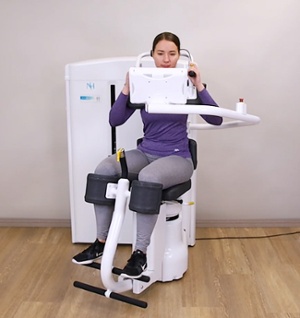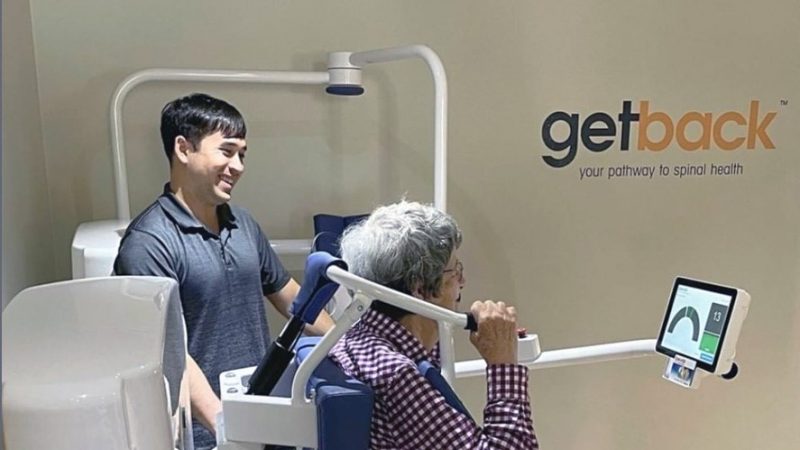1. Back Extension device
The DAVID back extension machine mobilizes the lumbar/thoracic spine, activating the target muscles in the sagittal plane. It allows people with severe and prolonged (low) back pain and lack of coordination and/or strength to do mobilizing and strengthening exercises. The movement is safe because it is controlled and therefore causes minimal discomfort. In addition, this innovative device is equipped with advanced software for testing and measuring isometric strength and mobility of the lumbar/thoracic spine in the sagittal plane.
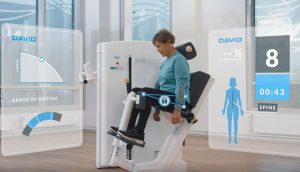
The back extension is an ideal device to treat the following back pain disorders:
- Non-specific Low Back Pain
- Herniated disc
- Sciatica
- Osteoarthritis (or spondylosis)
- Scoliosis
- Lumbar spinal stenosis
- post-operative treatment
What is critical in the design of a back extension device?
Biomechanics is the most crucial element. A well-designed back exercise prevents any harmful movements, is gentle on the joints but highly fatiguing for the muscles, and is easily fine-tuned for each individual. In addition, several studies have shown that exercise can act as medicine for painful joints. The spine, however, is a very complex structure involving vertebrae, discs, ligaments, dynamically functioning rotator and intervertebral muscles, and large, mostly statically functioning supporting muscles.
When back pain and loss of coordination are added to the equation, it is challenging to start exercise therapy in a controlled manner. As a result, medical back extension devices are required to isolate the target area and provide total control in the movement and loading. Read more about the ‘’10 reasons why you should use a medical back extension machine in case of back pain’’ in this blog article.
Hip-fix mechanism consisting of:
- Footplates adjustable to lower leg length
- Knee pads adjustable to thigh length
- Pelvis belt
- Seat adjustable for height
- Dorsal asymmetric back pad
The DAVID devices can be combined with additional active exercises.
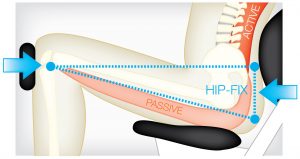
2. Torso Rotation device
The Torso Rotation Device mobilizes the lower back (lumbar/thoracic spine) in the transversal plane, activating the rotation muscles. Effective upper and lower body fixations ensure isolated rotation movement. The fixation mechanism is based on adjustable triangular pelvic fixation and lockable shoulder pads comprising of
- knee pads
- pelvic pad
- shoulder pads
The Torso Rotation is an ideal device to treat the following back pain disorders:
- Non-specific Low Back Pain
- Herniated disc
- Sciatica
- Osteoarthritis (or spondylosis)
- Scoliosis
- Lumbar spinal stenosis
- post-operative treatment
The DAVID devices can be combined with additional active exercises.
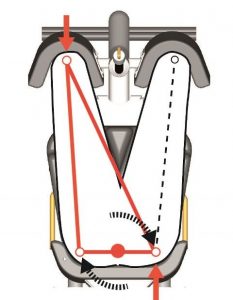
3. Lateral Flexion Device
The lateral flexion device movement mobilizes the lumbar/thoracic spine in the frontal plane, activating the lateral flexor muscles. Easy-to-use hip locking mechanism ensures that the pelvis stays horizontal and only the spine moves sideways. The DAVID devices can be combined with additional active exercises.
The lateral flexion device is an ideal device to treat the following back pain disorders:
- Non-specific Low Back Pain
- Herniated disc
- Sciatica
- Osteoarthritis (or spondylosis)
- Scoliosis
- Lumbar spinal stenosis
- post-operative treatment
4. Lumbar / Thoracic Flexion Device
The Lumbar / Thoracic Flexion device mobilizes the lumbar/thoracic spine in the sagittal plane, activating the flexor muscles. Asymmetric lumbar/thoracic dorsal cushion supports the spine ensuring that the movement takes place in segments of the spine starting at the thoracic level down to the lumbar level and back up again. This device is also a great tool for mobilizing a kyphotic upper back. The DAVID devices can be combined with additional active exercises.
The Lumbar / Thoracic Flexion Device is an ideal device to treat the following back pain disorders:
- Non-specific Low Back Pain
- Herniated disc
- Sciatica
- Osteoarthritis (or spondylosis)
- Scoliosis
- Lumbar spinal stenosis
- post-operative treatment
5. Cervical Rotation Device
The cervical rotation device movement mobilizes the cervical spine in the transversal plane, activating the rotating muscles of the head. This movement results in pure, isolated rotation, similar to activities in real life like when backing up in a car.
The Cervical Rotation device is an ideal device to treat the following pain disorders:
- Herniated disc
- Whiplash
- non-specific neck pain
- cervical spinal stenosis
- cervicogenic headache
The isolated movement (training with minimal weight) and advanced software allow for a steady increase in range of motion (mobility) without the patient having to break a pain barrier. The DAVID devices can be combined with additional active exercises.
6. Cervical Extension and Lateral Flexion Device
The Cervical Extension device movement mobilizes extension and lateral flexion of the cervical spine, activating extensor and lateral flexor muscles. Extension exercises are also helpful for upper back pain.
Fixation
Isolation of cervical muscles and adaptation to each test person’s segment lengths and body size by using movement arm, adjustable seat and chest pad.
The Cervical Extension Device is an ideal device to treat the following pain disorders:
- Herniated disc
- Whiplash
- non-specific neck pain
- Cervical spinal stenosis
- Cervicogenic headache
The DAVID devices can be combined with additional active exercises.
Exercise equipment and rehabilitation software is the perfect combination for the successful treatment of patients.
DAVID’s intelligent equipment is designed to have the best biomechanical properties. The EVE software is the advanced software system that makes DAVID equipment even smarter by testing and measuring functionality. In this video, you will find all the advantages of the EVE software.
Treatment of patients on the David equipment always requires an assessment by a professional. This professional is trained as a DAVID instructor and has been informed of the indications and contraindications for use of the exercise equipment.
 English
English 























